 |
Dynamical Systems in Jet Engines:
A Symmetry-Based Approach
|
| by |
Prashant G. Mehta
Department of Mechanical & Industrial Engineering
University of Illinois at Urbana-Champaign
1206 W. Green Street
Urbana, IL 61801
[email protected] |
Gregory Hagen
Components Department
United Technologies Research Center
411 Silver Lane
East Hartford, CT 06040
[email protected] |
Andrzej Banaszuk
Systems Department
United Technologies Research Center
411 Silver Lane
East Hartford, CT 06040
[email protected] |
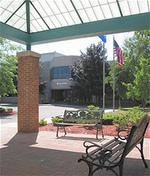 |
|
Jet engines are among the most complex
systems, with part counts ranging in the thousands, engineered by
specialists drawn from diverse core disciplines such as fluid
dynamics, combustion, acoustics, structures, and materials. Advanced
diagnostics and automatic control serve to maximize performance and
ensure stability in the engines. Static descriptors, such as part
counts, form the typical metrics of complexity in these systems.
However, there is another kind of complexity pertaining to the range
of non-equilibrium dynamic phenomena, turbulence being only one of the
many observed. |
| United Technologies
Research Center |
Given the parameter regimes of the physics, e.g. very high Reynolds
numbers, it is perhaps not surprising to the Dynamical Systems
community that the behavior is very rich dynamically. It may,
however, come as a bit of a surprise that some of the non-equilibrium
unsteady behavior is non-detrimental, even desirable. An example is
the turbulent mixing that is critical for combustion. Nevertheless, a
lot of the dynamic behavior, typically deemed instabilities, is
detrimental. Examples include combustion instabilities leading to
structural damage, turbulent jet noise leading to environmental noise
pollution, structural vibrations leading to fan blade fatigue and
fracture, and flow separation and instabilities leading to compressor
surge and stall.
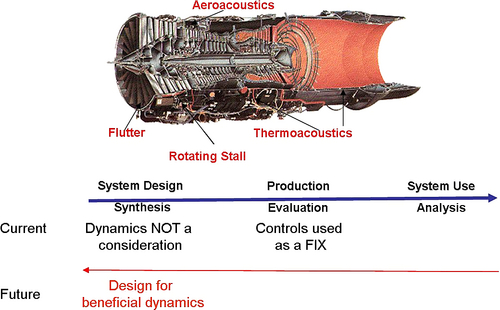 |
| Figure 1: Current
and future strategies for tackling instability problems in a jet
engine |
| Jet engines are high-energy devices and the
effects of these instabilities range from reduced performance to
catastrophic engine damage. A number of NASA films from the sixties
show rocket engines exploding on test stands, testifying to the
potential perils of combustion instabilities. Current fixes
include |
| a) |
operating in design space where these
instabilities are mild, |
| b) |
using diagnostics such as monitoring for blade
fatigue, |
| c) |
passive fixes such as weighty
liners that serve to dissipate acoustic energy in the case of
combustion instability, and |
| d) |
some active feedback control
approaches. |
|
 |
| The passive approaches
are at best a 'band-aid' on the problem, and come with increased
weight and cost, and decreased performance. Active control approaches
require accurate models for controller design, and most importantly
suffer from fundamental performance limitations due to physical
factors such as delay, actuator bandwidth, etc. |
| East
Hartford |
The fundamental problem here is that while the engine is designed
to be optimal with respect to the static performance metrics, it is
not designed so with respect to any dynamical behavior that may arise.
For example, even though combustion in a confined engine cavity is
good for thrust, the feedback coupling between resonant acoustic modes
of the cavity and heat released due to combustion can lead to
undesirable thermo-acoustic oscillations. What is needed is a design
approach that integrates the design of dynamics together with other
design objectives.
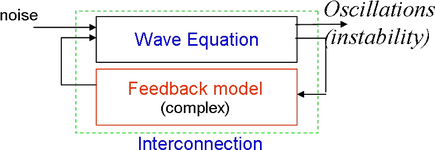 |
| Figure 2: Schematic
of an interconnected system where a wave equation is in feedback with
a dynamic model |
Two key technical barriers to analysis and design of dynamics are
- the complexity of the observed phenomenon, and
- the lack of suitable models.
This motivates our approach to utilize the structure in the problem,
namely its equivariance or symmetry properties. In the remainder of
this article, we outline some key ideas with the aid of a wave equation
on a circle in feedback with a dynamic model, of which only the
structure is assumed to be known.
Figure 2
depicts the schematic of the interconnection. Examples of wave
phenomena in jet engines include both acoustics and structures.
Feedback may arise as a result of combustion, leading to combustion
instability, or from fluid dynamics, leading to blade flutter. Even
though the observed instability phenomenon is robust and large scale,
the feedback models are generally very complex with spatio-temporal
uncertain dynamics on multiple scales. Traditional approaches
approximate these complex feedback models with either very coarse
models such as lumped delay, or with very fine-scale CFD descriptions,
which are not amenable to analysis or design.
Our approach, in contrast, is not to focus on the precise dynamics
of the feedback model, but to work instead with its structural
properties, such as symmetry. Our two main ideas are:
- the structure of the feedback can be used to explain the
instability, and
- manipulation of the structure can be used to control the
instability.
These ideas are almost without precedents in the aerospace research
community. After all, it is difficult to imagine symmetry in engines.
However, these ideas have been applied successfully to
| a) |
develop a set of computational tools to identify and
analyze time-series instability data from experiments, and |
| b) |
design changes on one of the
engines. |
The mathematics of these ideas is outlined below.
The first idea, based on methods of equivariant bifurcation
theory, is to use only the symmetry properties of the feedback model
in Fig. 2 to explain the instability. The wave
equation has the so-called spatial symmetry group O(2),
whereby the partial differential equation is equivariant with respect
to rotations and reflections. As a result of this, the individual
eigenvalues are double. Moreover, because of physical consideration,
these eigenvalues are lightly damped and close to the imaginary axis.
The double eigenvalues correspond to the fact that a
clockwise-rotating eigenmode is accompanied by its
counter-clockwise-rotating symmetric counterpart. The instability
phenomenon is related to the migration of one of these eigenvalues
into the right half complex plane because of the dynamics of the
feedback model.
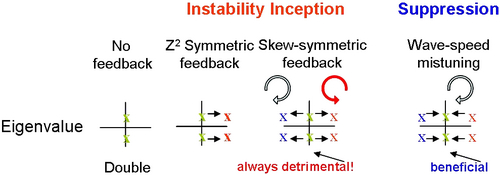 |
| Figure 3: The different
types of impact that symmetric and skew-symmetric heat release
feedbacks have on double eigenvalues of the
acoustics. |
To derive results on stability, we showed that under the
assumption of identical feedback elements (identical combustion
flameholders, identical fan blades, etc.), any feedback model can be
decomposed as a sum of symmetric and a skew-symmetric feedback.
Conceptually, the symmetric feedback corresponds to dynamics that
have reflection (about centerline) symmetry while the skew-symmetry
is a result of local asymmetry in feedback. Figure
3 shows the impact of symmetric and skew-symmetric heat release
feedbacks on any double eigenvalues of the acoustics. The symmetric
feedback causes the two eigenvalues to move as a pair in the same
direction. It can either stabilize or de-stabilize depending upon the
feedback model. The skew-symmetric feedback, on the other hand, is
always detrimental regardless of the feedback model. It splits the
eigenvalues, causing one rotating mode to gain damping while the other
rotating mode loses the same amount of damping. Using only the
time-series data from experiments, the instability seen in experiments
can be explained as a consequence of the skew-symmetric feedback.
The second idea is to modify the structural aspects of the model in
order to control the instability. This can be accomplished by
introducing precise spatial variations (mistuning) in the "mean
properties" such as wave speed of the wave equation. While the
skew-symmetric feedback causes the two eigenvalues to move apart,
mistuning causes the eigenvalues to move closer as shown in Fig. 3. In either case, the net amount of damping in
the system remains the same. This net damping depends upon the net
symmetric feedback due to the presence of liner etc. and is not
affected by spatial variation in mean. In effect, the mistuning
utilizes the more heavily damped system modes to augment the damping
of the lightly damped modes.
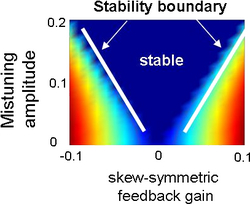 |
|
For a given skew-symmetric feedback (split of
eigenvalues), there is an optimal amount of mean variations that
reverses the detrimental effect of skew-symmetric feedback. This
optimal amount corresponds to the eigenvalue diagram where the
nominally double eigenvalues are the closest. Decreasing the amount
of mistuning from the optimal amount causes one of the modes to become
more damped at the expense of the other mode, which becomes less
damped. On the other hand, increasing the mistuning beyond the
optimal amount causes the frequencies of the two counter-rotating
modes to shift without any additional damping augmentation. |
| Figure 4:
Model-independent stability boundary as a function of skew-symmetry
and mistuning. |
The innovation lies in using only the symmetry structure of the
feedback model to carry out both the analysis of the instability and
design for its suppression. Skew-symmetry in feedback gives feedback
model-independent conclusion on stability, while mistuning of the mean
properties yields model-independent control of the instability. Figure 4 shows a model-independent stability boundary
as a function of skew-symmetry and mistuning. The optimal pattern for
the mistuning is related to the dynamics of the wave
operator. However, one can show that the conclusions are robust with
respect to mistuning characteristics.
| Validity of the analysis and design ideas can be
demonstrated in full scale devices. These ideas borrow heavily from
Dynamical Systems concepts, and result in a paradigm shift in both the
analysis of instability and the design for instability mitigation in a
class of jet engines. The success story highlights the role that the
Dynamical Systems community can play in analysis and design of complex
engineered systems such as jet engines. It is our sincere belief that
the results summarized in this article only reflect the tip of the
iceberg and "Design of Dynamics" will come to play an ever-increasing
role in the complex systems of the future. |
|
 |
| Connecticut around
Halloween |